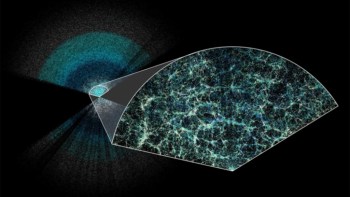Despite making up some 80% of all matter in the universe, we still know very little for certain about dark matter. In this interview with Physics World, the prolific Fermilab theorist Dan Hooper gives a fascinating overview of the topic and describes how various groups are racing to detect this elusive substance
In part one of the interview Hooper discusses the strong evidence for the existence of dark matter. This includes various astrophysical observations such as the dynamics of large-scale structures in the universe. “When we look at clusters of galaxies we find that they are much more massive, and have much more gravity associated with them, than their visual counterparts can account for,” he says.
Hooper explains that the favoured candidates for a dark-matter particle are “weakly interacting massive particles”, or WIMPs. As the name suggests, these particles appear to keep a low profile in the universe by interacting very little with all other matter. “They were created in the first fraction of a second after the Big Bang and more or less have existed without doing much of anything ever since.”
Hooper goes on to discuss the different types of experiment that have been created to try to detect dark-matter particles. One approach involves designing highly sensitive equipment capable of spotting WIMPs directly as they interact with detectors that are buried deep underground to shield them from background radiation. The other approaches Hooper describes look for indirect evidence of these particles using telescopes, or try to create dark matter at particle accelerators such as the Large Hadron Collider (LHC) at CERN.
Prospects for discovery
In the second part of the interview, Hooper speaks his mind about the prospects of discovery for these dark-matter experiments and some of the results to emerge so far. He believes that the scientific community is yet to see indisputable evidence for a discovery of dark matter, but some interesting “positive results” are starting to emerge.
Hooper shares his thoughts on one collaboration known as DAMA/LIBRA, which has been claiming for over a decade that it has detected dark matter, even though many in the community have remained highly sceptical of those claims. DAMA/LIBRA researchers have been reporting for 13 years that their experiment in Italy records a seasonal oscillation in its detections. This, they say, is caused by the Earth moving with (and against) a cosmic flow of dark matter.
Hooper believes DAMA/LIBRA’s claims could be strengthened if another experiment called CoGeNT, based in a mine in Minnesota, can observe a similar annual modulation in its detector. Since the interview was recorded early last month, CoGeNT has released new findings that seem to corroborate tentatively with the DAMA results.
But whatever comes of these claims, Hooper is confident that a verified discovery of dark matter could be just around the corner. “If I didn’t think it could happen then I would work on something else,” he says. “Any scientific goal has to have a plausible positive outcome or it’s not interesting and not worth doing.” What is more, Hooper is a scientist who puts his money where his mouth is. He tells the story of how four years ago he placed a bet with a colleague that dark matter would be discovered within five years. Despite there being just one year to run, Hooper still believes this is a good bet.



